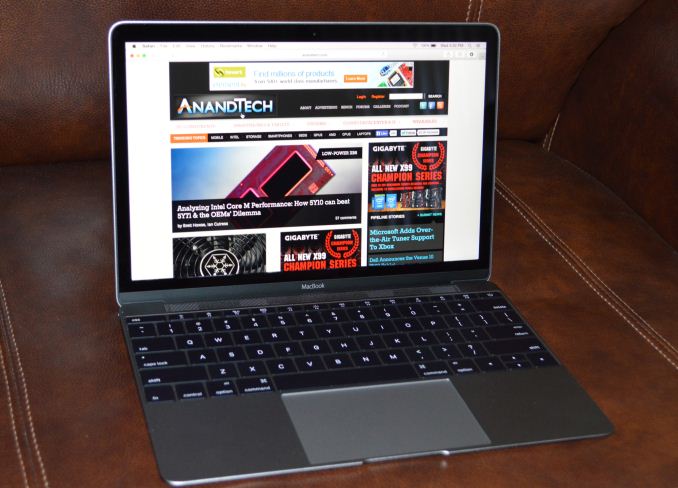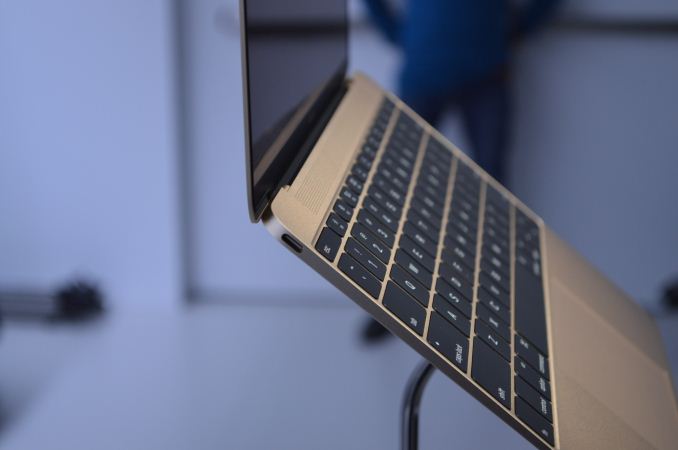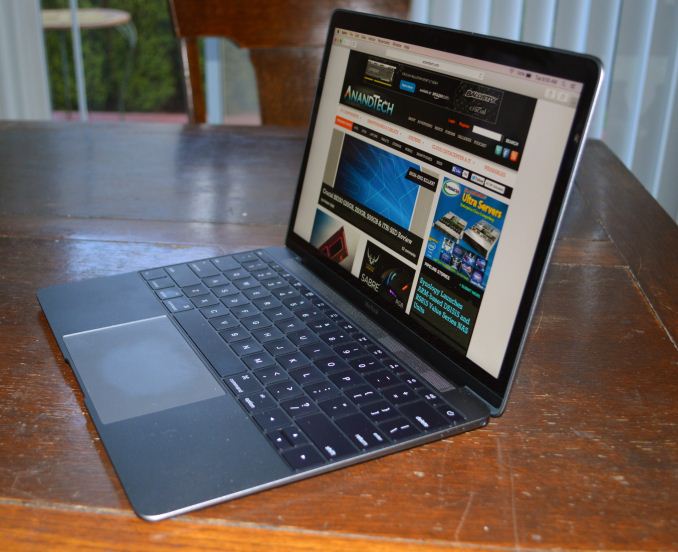The 2015 MacBook Review
by Ryan Smith on April 14, 2015 10:15 AM ESTFinal Words
Bringing this MacBook review to a close, I’m going to start where I left off in our introduction, which was the concept of the laptop/tablet crossover. The idea of laptops and tablets crossing over is no longer merely an idea, but now it is reality. Apple for their part may not be doing any kind of wild 2-in-1 transforming design, or even pushing the concept of a touchscreen OS X device, but they have clearly tapped their immense experience with tablets in putting together the new MacBook.
From a design perspective then the end product is clearly a Mac laptop, but it’s a Mac laptop that’s more tablet-like than any before it. From the small size, to the low weight, the choice of a Core M processor, the passive, fanless cooling system, and of course the choice of metallic colors, the MacBook pushes against the line that separates Apple’s laptops from their tablets.
There are of course numerous benefits and drawbacks from this, with some of them being obvious and others a bit more subtle. The biggest benefit of course is the size; the MacBook is a 0.92kg, 1.31cm thick professional grade Mac laptop, with many of great features that come with such a device. If the Retina MacBook Pro were miniaturized, then it would end up looking and behaving a lot like the MacBook that Apple is delivering today.
The biggest drawback in turn is what you give up to pack a full Mac into such a small laptop. Make no mistake, Core M is no slouch, and in bursting workloads can perform very well. But when faced with sustained workloads, a 4.5W processor can only go so far, and it’s not going to be able – nor is it meant to – keep up with the more powerful processors found in the MacBook Air and Retina MacBook Pro. The end result then is performance that’s anywhere between on-par with last year’s MacBook Air to the MacBook Air of a few years ago, depending on the specific task being run.
Meanwhile in the middle are a multitude of new technologies being first introduced in this generation. The new keyboard and its butterfly mechanism are certainly different, and the reduced key travel takes some getting used to, but once accustomed to it I like the stability of the keys. Similarly, the new Force Touch Trackpad is mechanically very different, and I’m still not sold on whether Apple is going to be able to find too many useful situations for the force touch capabilities. But on the other hand I’m definitely impressed with how natural the trackpad feels despite lacking a true switch mechanism and recreating that feel with an electromagnet instead.
Also deserving of attention is the MacBook’s 12” Retina IPS display. Particularly since the move to Retina Apple has been doing a great job on producing high quality pro displays, and the MacBook’s doesn’t fail to impress. The MacBook’s display’s out of the box performance is among the best we’ve ever seen, rivaling (and at times exceeding) the Retina MacBook Pro, which is to say that the end product is a very accurate, very sharp display. Mac users have been clamoring for a Mac ultra-portable with a Retina display for some time now, and although I don’t think the MacBook was quite what everyone had in mind, the MacBook’s display certainly is.
And then there’s Apple’s introduction of the USB Type-C port, which on such a small laptop like the MacBook takes on a whole new importance. Apple has always been on the cutting edge of I/O and their rapid adoption of USB Type-C is no exception. Relying on it for both I/O and charging is in turn a logical move given the interface’s capabilities, but I would also have to argue that Apple has taken it too far with just a single Type-C port. The Type-C port was the right call – teething issues and all – but Apple has unnecessarily hindered the MacBook by only giving it the single port. Even with its small, ultra-portable design there are still times where it’s desirable to charge the MacBook and use it with an external peripheral at the same time.
What we’re left with is a solid, though by no means perfect new entry into the MacBook family. I hesitate to call the MacBook a niche product since niche implies highly specialized when in fact the MacBook isn’t quite that specialized – it’s just small – but it’s clearly one product in Apple’s larger lineup. What the MacBook isn’t is a replacement for the Retina MacBook Pro or MacBook Air – at least not today – as it’s a laptop for users who already have other laptops or desktops; it is a second computer, not a first one. And admittedly this is the same designation that was applied to the MacBook Air on its launch several years ago, but as the Air’s performance has improved over the years and it was shifted to Apple’s entry-level laptop, it has certainly become the sole computer for an increasing portion of its user base.
Speaking solely for myself here, I’ve come away rather impressed with the MacBook. As an 11” Ultrabook user I already have a fondness for the weight and size of the form factor, and as a journalist frequently carrying around a laptop to trade shows and meetings I particularly appreciate the reduction in weight. The regression in performance is unfortunate, but the combination of weight, battery life, the Retina display, and the keyboard in my mind more than make up for the performance the MacBook can’t offer. After all, I have a workstation for when I need performance; what the MacBook fulfills is delivering acceptable performance when I’m away from that workstation and need portability over performance.
Briefly, I also want to touch on price. The MacBook’s $1299 starting price tag is very much an Apple price tag – which is to say expensive – however it’s also one that goes hand-in-hand with markedly improved base specifications for an Apple laptop. The 11” MacBook Air starts at just $899, but as Apple’s entry-level laptop I will also argue until I’m blue in the face that it’s underequipped for 2015; 4GB of RAM and a 128GB SSD aren’t enough. Which is a point I make because after upgrading the Air to a more acceptable 8GB of RAM and a 256GB SSD the price tag is up to $1199, at which point it’s only $100 off of the MacBook. At least compared to the rest of Apple’s lineup I find that the base MacBook isn’t so much expensive as the base MacBook Air is just a bit too cheaply built.
Anyhow, on a broader note, while I doubt Apple was looking quite this far into the future when they created the initial MacBook Air, I get the distinct impression that this is the kind of device they have been building towards. Apple has always been held back by technology to some degree – be it processor size, storage size, or display power requirements – and it’s only now in 2015 that the pieces have come together to allow them to make a laptop this small. I don’t believe this is a stopping point for Apple simply because one way or another they’re going to keep iterating, but compared to the MacBook Air there isn’t the same need nor ability to make a MacBook even smaller.
Which brings me to my final point, which is the future direction of the Apple’s Mac laptop families. The fact that the MacBook is the MacBook, and not the MacBook Nano or some other named MacBook is something I believe is telling. Although there’s clearly a risk in reading too much into Apple’s future plans based on a name alone, I have to seriously wonder where the MacBook and the MacBook Air go from here. Apple still needs an entry-level Mac laptop, but do they need the MacBook Air in particular? Just as the newer MacBook Air rendered the previous generation MacBook redundant in due time, I suspect Apple may intentionally following the same course with the new MacBook. But as to whether that comes to pass, only time will tell.













354 Comments
View All Comments
nyoungman - Wednesday, April 15, 2015 - link
> Given a light workload that allows the Core M CPU instead the MacBook to turbo to its fastest speeds (pg10)Core M CPU instead the MacBook?? huh?
> base MacBook isn’t so much expensive as the base MacBook Air is just a bit too cheaply built.
or cheaply "specced"?
Ryan Smith - Wednesday, April 15, 2015 - link
Got it. Thanks!DanaGoyette - Tuesday, April 14, 2015 - link
From trying out an HP convertible tablet with the Core M-5Y71, I can say that the processor does seem fine for many uses. Heck, it even managed to play a 10-bit 1080p h.264 video.However, I do have to ask: What was Apple thinking when giving it only ONE type-C port? Was there really no room for a second? Why does their dongle offer only HDMI, instead of DisplayPort?
I also don't get why Apple didn't use WiGig (802.11ad), to offer a magical docking cube.
iwod - Wednesday, April 15, 2015 - link
The Macbook, is already attractively priced for those who want a Macbook Air with Retina display.For those who want even faster performance, I am sure in 18 months time you will get 10nm version of Skylake, SSD using PCI-E 3.0, LPDDR4 RAM, and 802.11ac WiFi 160 MHz channel bandwidths will solve all the problems mentioned in this article.
victorson - Wednesday, April 15, 2015 - link
I'm a huge fan of AT, but guys, come on, you should be able to get a cheap dslr with a flash and take some at least decent photographs for your reviews. This is just horrible.Ryan Smith - Wednesday, April 15, 2015 - link
All of this was shot on a Nikon D3200.mazz7 - Wednesday, April 15, 2015 - link
Great articles since Post-Anand, nice work Ryan enjoy your full blown articles :)Ozy - Wednesday, April 15, 2015 - link
The 5Y71 on your other review is listed as having vPro and the 5Y51 does not. Can you tell me how that impacts the mac? I have a 5Y51 1.2 model delivering shortly but may consider returning for a 5Y71 model if the vPro gives the unit Hyperthreading. Does the 5Y51 have HT?Gigaplex - Wednesday, April 15, 2015 - link
vPro is unrelated to hyperthreading. I don't think Macs even support vPro. It's a marketing term for enterprise features like remote management, security, virtualization and networking features.damianrobertjones - Wednesday, April 15, 2015 - link
"but it’s a Mac laptop that’s more tablet-like than any before it."Does it have a touch screen? No.